The heartless mercy
[1] A reconstruction of the likeness of Christ and His the damage caused by Passion, based on the Shroud of Turin.
[2] This thesis can be easily proven, theologically and psychologically. Vulnerability of God is a part of being human; Christ is fully human as much as He is fully divine hence, he is vulnerable not only to a physical but also an emotional hurt as the Gospels reveals it on a number of occasions, for example in Gethsemane when his closest disciples failed to stay awake and keep Him company in the darkest hour of his emotional abandonment. His words “Are you still sleeping and resting?” are nothing else but the expression of a very humane hurt. Apostles did not think of Him enough and that hurts.
[3] In psychology, a real or a true self is understood as a healthy core of a person. An acting true self is experienced by a person as “feeling fully alive”, “being real”, “living in a moment fully” and so on. A fake or a false self is typically formed by a child as a survival system, out of a need to please her parents who were using a child as a tool for self-gratification moulding her into what they wanted regardless of her objective good. As a result, a child loses a touch with her true self mostly or, in the cases of narcissism, completely and comes to identify herself with a fake, to the point of dissociating when someone confronts the fakeness of her fake self.
[4] By being “nice” I mean an insincere people pleasing behaviour learnt for survival purposes, not a good behaviour of a kind person that is a natural expression of their inner goodness.
[5] St. Catherine of Siena Exchanges Hearts with Jesus.
[6] Mathew 15:19
[7] Various saints and mystics of the Church, before and after St Margaret Mary Alacoque, paid a special attention to the Heart of Christ; some received visions centered on His Heart.
[8] A heresy of Jansenism attempted to twist Christianity into something hopeless and anxious; it also favoured a seldom communion. In essence, Jansenism undermined the reality of an attachment of God to humans.
[9] “We must then dig deeply in Christ. He is like a rich mine with many pockets containing treasures: however deep we dig we will never find their end or their limit. Indeed, in every pocket new seams of fresh riches are discovered on all sides. For this reason the apostle Paul said of Christ: In him are hidden all the treasures of the wisdom and knowledge of God.” (St John of Cross, ‘Spiritual Canticle’).
[10] In this paper I consider only the original image because its description was a part of the vision of Sr Faustina. The orders received by her in her communications were about that exact image. “By means of this Image I shall be granting many graces to souls; so, let every soul have access to it.” (‘Diary’).
[11] The halo with a cross in it is a unique attribute of Christ in the Western and Eastern sacred art, no one else can be depicted with it.
[12] Sometimes, on some images (typically on the Eastern icons of Christ Pantocrator, “the Almighty”), one can see Christ without stigmata however He always retains His peculiar halo with the Cross. On the majority of the images though and definitely on those that have a reference to His Passion and death, He has stigmata as well as the Cross.
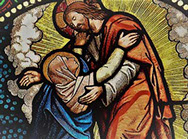
[13] Like an ancient Eve was born from the side of Adam.
[14] John 6:53.
[15] One can paint a good Samaritan though and it will be a symbolic representation of Christ’s mercy; here the lesser signifies the bigger.
[16] It seems to me also that his words “Unless I see in His hands the print of the nails, and put my finger into the print of the nails, and put my hand into His side, I will not believe.” are more the words of someone who is afraid to believe and be disappointed, after the shock of Crucifixion.
[17] Among other things like claiming to have some “sacred knowledge” Gnostics denied the reality of Crucifixion and denigrated the Humanity of Jesus. See the works of St Irenaeus of Lion for further information.
[18] This I think may partially explain the numbness of so many Western believers to the icons or other “complex” depictions of Christ. They are too “unfriendly” or “painful” as I was told.
[19] Especially if a person suffered an emotional trauma like abuse, neglect etc. earlier in life.
[20] ‘Diary’ of Sr Faustina. In a Christian mystical tradition communications which inflate a sense of own exclusivity/superiority/pride is considered to be suspicious, which source is unlikely to be divine.
The Sacred Heart of Jesus
I first saw the statue of the Sacred Heart of Jesus in France, I think. Soon I was to see many of them; almost any Catholic church I went into would have one. Although I perceived that image as somewhat weird (for an Eastern Orthodox), with a three-dimensional heart sitting on the chest, I was drawn to it somehow.
An Eastern Orthodox typically objects the devotion to the Sacred Heart on the grounds that a heart is a part of the body and we are devoted to the whole Christ (to venerate a bodily part is a kind of heresy some say). I must say the objection made a sense to me, although not for the theological reason but because the heart of Jesus, being venerated separately from Him, did not work for me psychologically. My attitude changed when I read the words of Christ addressed to St. Margaret Mary Alacoque (1647-1690, France) in a vision of Him with His heart being visible:
“Behold the Heart which has so loved men that it has spared nothing, even to exhausting and consuming Itself, in order to testify Its love; and in return, I receive from the greater part only ingratitude, by their irreverence and sacrilege, and by the coldness and contempt they have for Me in the Eucharist.”
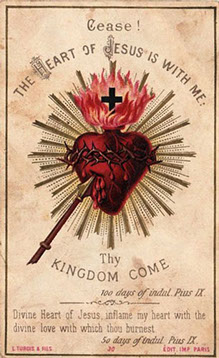
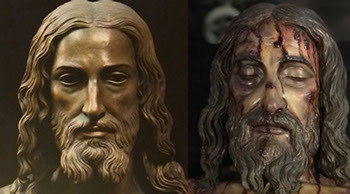 [1]
[1]
Then I understood that the Heart depicted outside of the body, pierced and squeezed by the Crown of Thorns, with the Cross on the top of it aflame and with the rays of light coming from it is simply a symbolic expression of the emotional suffering of the Son of Man caused by His love for us and not just that – it is an invitation to the painfully (for the human with a heart) real relationship with Him. It is a symbolic expression of the Love of God Who suffers because His Sacrifice, made out of His burning love for the humanity, has been rejected, mocked, ignored or otherwise abused by most. It is an utmost expression of the vulnerability of God, God Who can be vulnerable only in Incarnation.[2]
Precisely because in the Person of Christ both Man and God are vulnerable it is so important for the statue of the Sacred Heart not to be sweetly sentimental, I think. Far from conveying “sweetness”, it is supposed to convey the pain of the Man and the pain of God Who has exhausted all means for winning the love of His creatures and yet is still being denied by so many. There is nothing left; God died so that men could live and nothing can be added to that fact. One can detect an anger in the words of Christ to St. Margaret Mary Alacoque – again, very understandable anger at the loss of the souls and possible relationships – all that despite the bloody Sacrifice.
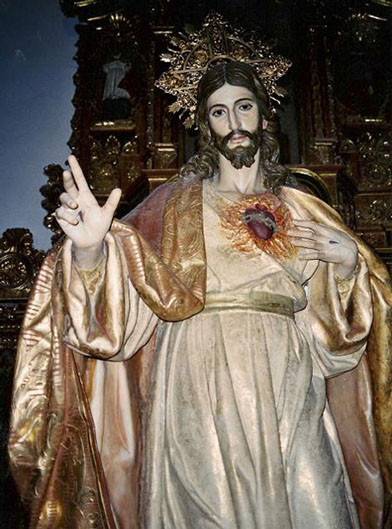
I would like to highlight a very human aspect of the message given by the Son of Man to the French mystic. It is entirely normal, for a human psyche, to love and to desire reciprocal love; it is normal, when one loves someone, to wish for them all possible good and to try to save them from a mortal danger; it is normal to be beside oneself if one sees that the other is turning his back on the sacrifice which is also the means of their salvation from the eternal death. Finally, it is normal, for a normal man, to reveal his vulnerability, to risk, stating his love and revealing his pain at the loss. Yes, Jesus as He is depicted on the image of the Sacred Heart is risking to bring even more mockery and spite upon Himself – if He is God how can He be like that? Isn’t God is supposed to be far above, not “needing” anything, not heartbroken or at least not exposing Himself like that?
Yet if one wants a true relationship, he must be true to who he is. To enter into the relationship with Jesus Christ means to know about His pain as well as about His majesty and omnipotence. And not just that: one must also repent and change within themself that what causes Him pain. Such repentance and reparation have nothing legalistic about that – it is simply a necessary ground or condition for the real relationship (to insist that the true relationship does not need such a ground is, according to human psychology, a hallmark of emotional abuse). In this respect God is not different from us. It would be impossible to be in a true, meaningful relationship with someone who repeatedly and deliberately offends us and does not even think of repenting and repairing the damage to the relationship. It would be impossible because if we can do that then one of the following is true: either we do not care about our own pain and dignity (typically covering it by the thought that we are very compassionate or “above” such things) or the other person does not care about our pain and dignity, or both.
Whatever it is, there is no real relationship there but a pretense, a fake, not a meeting of two persons. Fundamentally, it is a denial of one’s personhood and that of the other, always perpetuated for the purpose of obtaining some benefit. While such a shell of a relationship is possible between humans, it is impossible between a human and Christ. First, because Christ can deny neither His own Personhood nor the personhood of the other. Second, Christ does not just give some benefits = some good to the humans, he Himself is the ultimate Good. He is the Way to eternal life and He is that Life Himself hence no one can get anything out of Him while not seeing Him as a Person. Here God checkmates humans with their inclination to care about the benefits of the relationship much more than about their source, to the point of forgetting about the source’s existence. “You want a true good – then you have to relate to Me, the only source of all true good i.e., to face Me and see yourselves as you are in the light of that Truth” – says God in Christ.
And, if in the case of two people a fake of a relationship means “only” the loss of a true human connection, in the case of Jesus Christ a fake of a relationship with Him means a loss of literally everything including the possibility of theosis, because that transformative process into likeness to God is only possible via a relationship with the Person of Christ Who, via a relationship with Him, transforms the human psyche, re-creating the person as he was supposed to be.
To sum it up, the denial of personhood (one’s own and of the other) via refusal to feel and acknowledge the hurt (one’s own and of the other including Christ) and to deal with the evil that caused the hurt is effectively a refusal of true theosis and instead, an acquirement of its oblique imitation, a nice substitute, something that has some seemingly higher qualities (or even “god-like” as some think) like being “above” the hurt, being “forgiving”, being nice benefactors of those who clearly want only the benefits and do not care about the benefactors, even to the point of abusing them and so on. God after all is supposed to be benevolent and nice; he distributes the goods from above without asking anything in return hence the unconscious superiority and entitlement of a “nice” person that grows out of the sense of vague affinity with the imaginary “higher” or “divine” qualities.
A superior figure
Ironically, this phenomenon is trivial and well known to clinical psychology. It is someone who, from a tender age, has been conditioned by her caregivers to forfeit herself – the so-called true or real self[3] – together with her own legitimate needs, for the sake of being pleasing to others and catering to their own emotional needs. A grown victim of emotional abuse (making a child to give up herself is a form of the most insidious abuse), taught that being “nice”[4] is the only acceptable mode of existence, typically does not react in a normal way to a pain in her adult life. She habitually minimizes or reinterprets emotional pain (not just her but also other’s) because she was conditioned not to validate and to express it as it is “not a nice thing to do”. Being “not nice” that is, a helpless abandoned “outcast”, is her deepest unconscious fear; on the surface though she lies to herself saying that she is not afraid, she is simply “above” the pain and the abuser, she is just a very nice person, even God-like perhaps because she is so selfless, above her own needs.
In reality though a nice victim derives her sense of self (a fake self) and self-worth from her non-confronting the abuse so she is not selfless at all. Far from being above the abuser, she depends on him – “a nice person” depends on the “evil one” for her (fake) validation and this is why she continues enabling the abuse. Her feeding her own fake self – not the real self that feels the pain and wants it to stop – enables the evil to continue.
Very importantly, “being nice” for such a person is not just a learnt mode of existence and a source of (perverse, based on a self-delusion) self-gratification but also a means of manipulation and control of others. It is a bullet-proof method precisely because it is so “nice”. It is very difficult, for most people, to confront such a “nice person” who packs her subtle manipulation in the recognition of one’s grandeur conveyed by unrestrained admiration and exaggerated phrase.
To expose the true worth of such a nicety, I invite the reader to consider it in the light of Jesus Christ:
- Christ uses His pain as a tool for the supreme Good, confronting with it the evil in the believer. A “nice” victim suppresses her pain for the sake of “nicety”.
- Christ is direct in His demands. A “nice” victim engages in indirect manipulation.
- Christ is painfully clear and realistic about the state of the souls He deals with. The victim of abuse habitually glosses over the abuser so she would be able to continue “being nice” to him. In fact, she glosses over just anyone for the sake of being able to remain “nice”.
- Christ goes out of Himself to cause people to relate to Him as He truly is (this is why He allowed them to kill Him; if, hypothetically speaking, He gave up His Self He would not be killed). A “nice” victim is desperately trying to hide behind her fake self.
- Christ does not avoid the risk of being seen as “not nice”, for the sake of the good of the other. The “nice” victim is terrified of being seen as not nice so she habitually sacrifices the good of the other (and her own good) for the sake of her “nice” image.
The list could be very long. It will suffice to say that every vector of a heroic action of Christ Who is trying to save humans from the deadening fakes and, ultimately, from the eternal death has its counterfeit, a parody in the action of a “nice” person. Most important among those opposing vectors, to me, are of Christ attempting to shake others out of the fakes = their fake selves via bringing them into His (true) reality for the sake of a true relationship, attachment, connection while a “nice” person desperately avoids any true reality, any possibility of being seen as she is and of seeing others as they are – avoids via “nicely” gliding over their surface.
A seeming connection, a seeming relationship is a deception, a lie that stands here in the opposition to the truth, of the inconsiderate and “not nice” demands of the Lord.
This is why I think our salvation is not something that can be simply obtained, in baptism and then via going to the church on “the days of obligation”. That would be too easy, for us. No, to become grafted into Christ means to suffer the pain of seeing our own hopeless unsuitability for such a graft and yet to remain there, in that unbearable true reality where the evil must be confronted and burnt down in by light of Christ. A human being is saved of course via accepting the Salvation in Christ yet he must be saved in progression so to speak, via allowing the Person of Christ to transform his person in a constant and conscious communion with Him. This process is well-known and described in detail by many mystics, Catholic and Orthodox, yet it is the path that all must take I believe. It is a process of removing our stony, numb, “nice” hearts and replacing them with the living, feeling hearts.
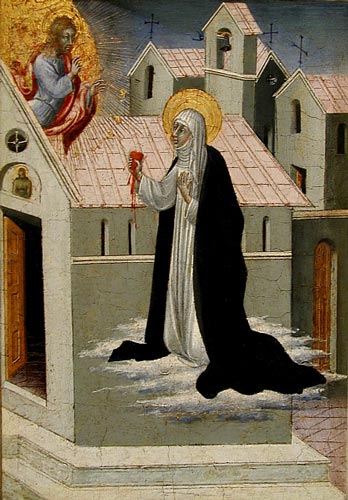 [5]
[5]
To sum up, a relationship with Christ is a relationship with Someone Who has a heart and Who is trying to relate to you while seeing you as you are, despite your vileness yet not ignoring it. He does love you yet He is desperate for you to be raised up from your stinky swamp of self-destructive actions and thinking because to do otherwise would be to abandon you. Yes, paradoxically, a confrontation of one’s sin is a manifestation of an attachment while the ignoring one’s sin is a manifestation of an abandonment albeit veiled but precisely because of that even more destructive. It is, in essence, “too painful to face it”, “not seeing is more convenient for me” and, of course “I am afraid of not being nice”. It is thoroughly selfish and the exact opposite of the “non-niceness” of Jesus Christ.
Why am I writing this? – Because without it as a background it would not be possible to examine a relatively new phenomenon, a Christ without a heart.
A Christ without a heart
In a preparation for the examination, it is important to recall an obvious point, that the Sacrifice of God for men has been done. It was accomplished, accepted by some, preached around the world. That very fact, of the death of the Son of Man and the Son of God on the Cross, killed by humans, has been depicted exactly as it happened by countless Christian artists. The depiction of the figure of a man in a crown of thorns nailed to the cross, with his side being pierced and bloody liquid pouring out is probably the most recognizable image in the world. It is completely meaningless to the world yet if you ask anyone what is depicted, most would say “This is a crucifixion of Christ. Christians believe He is God.” The more educated may add that Christians somehow see the death of that man on a cross as the salvation of the human race. He died to save the world. Believe in him and you will be saved. This thesis makes no sense to non-believers of course but the narrative related by them is as recognizable to Christians as a regular depiction of the Crucifixion.
Christ of the vision of St Margaret Mary Alacoque did not appear to her dead on a Cross. He appeared as He is now, after the Resurrection but with the marks of the Crucifixion on His body, confined by His love and mercy to wait until the time runs out, offering His Heart = His Love to all. “See Me as I AM, the suffering Person, I suffer because I have to see my creatures perishing by their own choice. You could have the fullness of love in eternity with Me, the Source of Life but you are choosing death because you are choosing yourself, your fake self. This is a deception of the devil and it is unbearable for Me to see.” It is, in essence, an offer of an ultimate secure attachment, to the humanity that numbed itself to its core need, of being attached.
The Scriptures understand the heart as the spiritual center of each human being. A heart, good or evil, is who a person is. “For out of the heart proceed evil thoughts, murders, adulteries…”.[6] Hence the image of the Sacred Heart can also be interpreted as Jesus Christ offering His very core, Who He Is. There are also other interpretations which connect the image of the Sacred Heart with His Love that finds its utmost expression in His establishment of the Sacrament of the Eucharist; the revelations of the Sacred Heart to the mystics very often have references to the Eucharist and to its abuse. Christ loved us so much that He left for us not just “remembrance” of His Last Supper but Himself in the Eucharist, until the end of time. (It is legitimate albeit very chilling to say that the Love of His Heart made Him leave His Heart, in the Holy Communion, for us.)
Hence the image of the Sacred Heart also has the ancient connotation, of the very core of our faith – of the Eucharist that began even before the Gospels were written and the Creed formulated. I repeat, the Eucharist is the very core of our faith because in it we receive Christ Himself. This is possible only because of His Heart = because He loves us.
This notion, of Him loving us to the end, has been known from the beginning of the Christian Church. It is because He loved us, He did all that the Creed outlines. There was no other reason whatsoever for Him to dwell among us and to die a violent death.
Various images of Him – frescos, icons, paintings created over centuries show Him not as heartless although they do not show His heart. Since He was fully human it was obvious that He had a heart. St John the Evangelist while leaning on His breast during the Last Supper even heard that Heart beating in premonition of the Passion. The tradition of the depiction the Sacred Heart as it is known now came as a result of the visions of St Margaret Mary Alacoque but the devotion to the Sacred Heart of Jesus itself was not new and did not proclaim anything theologically new.[7] It attempted to restore the theological and psychological normality, urging people to turn to the real God – not a cold and detached God of Jansenism[8] but suffering, loving and compassionate God, in Christ – especially through the Eucharist, repentance and reparation. It seems to me that true experiences of true mystics, if we look at them through the centuries, always try to return the diverted focus back to Christ the Person, Christ in His Sacred Humanity (contrary to Gnostic attempts to reap Christ of His Humanity). And, if we have the fullness of God’s revelation about Himself in Jesus Christ then it is logical to assume that humans must strive to know more and more intimately that last revelation, the Word of God = the Person of Christ[9].
Now to the image of Christ without a heart at last.
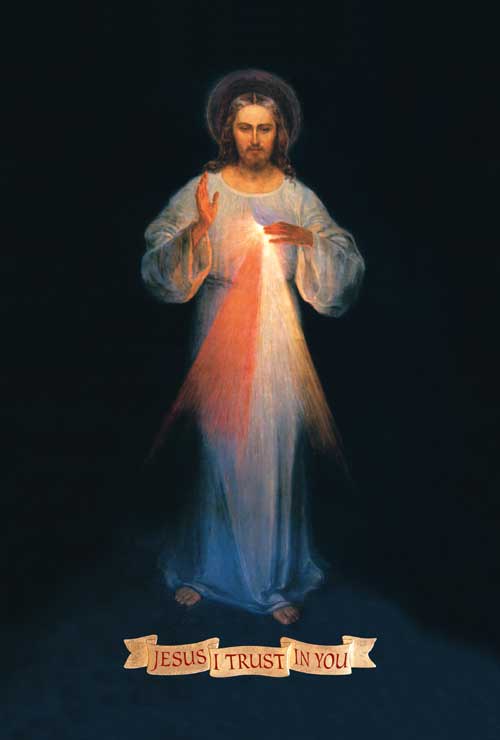
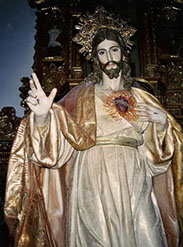
This is the original image[10] called ‘The Divine Mercy’ as it was revealed in a vision to Sr Faustina in 1930s. It depicts a Christ-like figure whose body position repeats the iconography of ‘The Sacred Heart of Jesus’ (on the right). Unlike the Sacred Heart, the Christ-like figure is lacking all typical attributes of Christ: stigmata (marks left by the nails) and the shape of the Cross in the halo, a symbol of His Crucifixion.[11] Those attributes allow the viewer to know for sure that the depicted is Christ.[12]
Unlike Christ on the image of the Sacred Heart given here for a comparison, the depicted on The Divine Mercy image is not trying to engage with the viewer. He does not look at anyone, he is self-absorbed, with some vague smile. As I wrote in my paper ‘The Antipriest’, Christ as the One Who always relates to the other (to the viewer or to the depicted with Him) and this is why the icons which depict Him as non-relating are profoundly false.
Although the iconography of the figure on ‘The Divine Mercy’ painting was clearly copied from the iconography of the ‘Sacred Heart’, the very point of the original iconography – the Heart – is missing. There is nothing there and from that nothing two rays are coming out, red and white.
While (assuming that the depicted is Christ) the rays are a reference to the blood and water which came from the side of Christ after His death of the Cross when the Roman soldier pierced His side here, in the context of the alive figure without a wound the reference looks out of a place. Iconographically, it is as strange as a depiction of the resurrected Christ not just with the nail marks but with the blood gushing out of where the nail marks would be. Or even more to the point of the discussed image of the Divine Mercy: the depiction of the Resurrected Christ without the marks of nails but with the blood gushing from the places the marks are supposed to be.
I wrote this and thought that some may perceive my thoughts as being simplistic – two rays, red and white, here are the symbols, after all. The problem is that in Christianity symbols always represent the reality behind them; they cannot be separated, severed from that reality and placed in a different context without changing their meaning and even the reality they convey. And the reality is that the real blood and water were poured out from Our Lord’s side at a particular time and place. Those facts the early Church has symbolically interpreted as pointing to the two major sacraments, Baptism and Eucharist together with the birth of the Church from the side of the Lord.[13] However, no matter how the blood and water poured out of the side of Christ are interpreted, their interpretations have their source in the fact, primary to the symbolism and awful in its medical reality: Christ truly died and it was Crucifixion and ataxia that made his body accommodate a huge amount of water and this is why blood and water poured in abundance. Blood and water belong to the moment of His death; they are a confirmation of the reality of His death, of the real Human, on the Cross, the accomplishment of His mission. This is why they have never been depicted coming out of the living Christ or “symbolically” like rays or lines or something else like the Eucharistic Cup and a baptismal font.
But why the image of the Divine Mercy must have those two rays? (I will note here in passing that I do not remember even a single image of Crucifixion where water and blood were depicted separately. I do not even think such images exist.)
From the diary of Sr Faustina:
"The two rays denote Blood and Water. The pale ray stands for the Water which makes souls righteous. The red ray stands for the Blood which is the life of souls."
So indeed, they are not blood and water but the symbols of the blood and water.
I read and reread this quote several times. A strange construct “two rays are the symbols of blood and water and the blood and water are the symbols of the Eucharist and Baptism” that emerged in my mind as a result of reading and looking at the image of ‘The Divine Mercy’ sent my mind into stupor. Until the Divine Mercy cult, we had the dead Christ on the Cross with clearly depicted Blood and Water, not their symbols, coming out of His side, giving birth to the real Church with its real Sacraments; the real Blood and Water can be symbolically interpreted as two Sacraments. Now, according to the Divine Mercy, we have a symbolic representation of Blood and Water coming out of the living figure and “giving birth” to the reality (or the unreality?) of the Blood and Water so to speak. Perhaps it happened because the two Sacraments were not named. Indeed, I assumed that they were meant. Whatever it is, in the first case (the death of Christ) the reality is a source of a symbol, in the second case (the Divine Mercy) the symbol, severed from the reality, seems to be trying to re-create (or create a new) reality, at least on the painting.
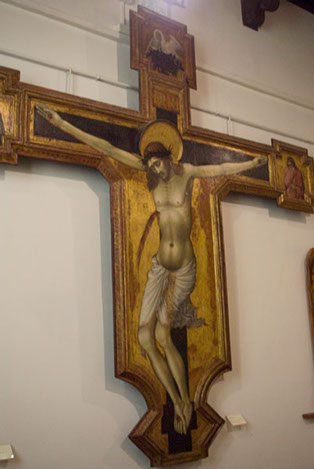
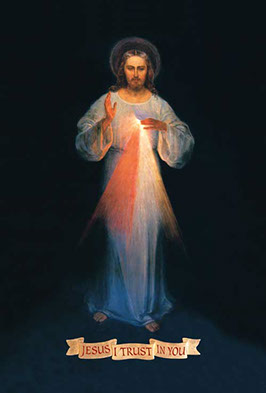
In an attempt to pin down something oblique that I perceived there, something that keeps changing its shape and impossible to pin down without placing it in a context of something solid and definite, I brought the discourse almost to the level of free associations. The question remains, why the symbols of Blood and Water, what is the need to use them? In Christian art the clothes of Christ are conventionally given blue and red colours out of the need to convey the dogma of His two natures, human and divine. It is impossible to convey this dogma otherwise than via symbolism, in this case the symbolism of colours. Yet it is perfectly possible to paint blood and water without implementation of the symbols. Blood and water can be depicted not necessary very realistically yet in a way that they remain such and not being transformed into something ethereal like rays.
I wrote this paragraph and realized that the source of the absurd construct “two rays are the symbols of blood and water and the blood and water are the symbols of the Eucharist and Baptism” was the image of ‘The Divine Mercy’ itself. Even though the passage “The two rays denote Blood and Water. The pale ray stands for the Water which makes souls righteous. The red ray stands for the Blood which is the life of souls.” is murky, there are at least the words, Blood and Water are there, however interpreted. On the painting there is nothing, the last reference to their reality disappears.
It appears that my intuition was correct. To check the explanation of the rays again, I read the whole entry from Sr Faustina’s ‘Diary’:
“The two rays denote Blood and Water. The pale ray stands for the Water which makes souls righteous. The red ray stands for the Blood which is the life of souls. These two rays issued forth from the depths of My tender mercy when My agonized Heart was opened by a lance on the Cross. Happy is the one who will dwell in their shelter, for the just hand of God shall not lay hold of him.”
Hence two rays, red and white, appear to be the only reality – during the death of the speaker and after it. Not the Sacraments which the rays “denote” but the rays which “makes souls righteous” and “the life of souls”. It is tempting to comment that the statement which seems to say that those who dwell within those rays will not be judged by God, but I will refrain from it for several reasons, one of them is that the passages are constructed so skillfully and murkily that it is perfectly possible to claim that by the two rays the Eucharist and Baptism were meant – although not being judged by God has never been promised to those who are baptized and receive the Eucharist.
Instead of engaging in a theological argument I would like to invite the reader to compare the murky passage with the real words of Christ. Take the statement “The pale ray stands for the Water which makes souls righteous. The red ray stands for the Blood which is the life of souls.” and try to understand how it may relate to your spiritual life, your personal relationship with God. Then, after labouring for a while, take the words of Christ: “Truly, truly, I say to you, unless you eat the flesh of the Son of Man and drink his blood, you have no life in you.”[14] Here, being exposed against the true words of the Lord, the words “the red ray stands for the Blood which is the life of souls” somehow look as… totally unnecessary, being separated from the gross reality which made the majority of the followers of Christ leave Him. They would not leave Him if He extracted some mana or “energy” from heaven and said “partake it and be saved”. What I am trying to convey here is the extremely direct and personal character of the words of Our Lord Who names things as they are. Furthermore, His words reflect Him to the extreme. He is real in His words. It is the concrete and personal character of His words (and Himself) in the Gospels that make the words related by Sr Faustina impersonal and unconvincing.
“But”, someone could remind me, “it is simply an explanation of the symbolism of the two rays on ‘The Divine Mercy’ image.” To which I answer, “Very well, but what relevance has it to us, to our relationship with the Lord? Do the vision, the image and the words give us anything we lack?
* * *
Before I looked into the explanation of two rays on the painting, I somehow thought they would have something unique to do with the Divine Mercy. Those who practice that devotion say that 3.00pm, the time of the death of Christ on the Cross, is the hour of the extreme outpouring of the Divine Mercy. Then it appears that those rays are simply an indicator of the death of Christ on the Cross. His death is the utmost expression of the Divine Mercy thus the attribute of that death. This is not what I read in the materials of the Divine Mercy cult but my attempt to explain the iconography logically.
However, why in this particular moment is the Divine Mercy at its pinnacle? The Incarnation of Christ in our world was the action of the utmost mercy so as His whole life with us in its totality – His ministry, His Passion and Crucifixion which culminated in His death. And even if someone insisted that it is not so, it was still Him = the divine mercy incarnated, dwelling with us because He chose to be born to sacrifice Himself for us; He has spent His earthly life knowing and willingly choosing that end.
What I mean is that Christ is the divine mercy incarnated, its personification. And not just mercy – Love first and foremost, Love that includes mercy and its many other aspects like justice, the Love of God the Father. If it is so, the red and white rays can add nothing to His Person because any true icon of Him is the icon of the divine mercy as well, in His Person. In fact, we even have the icons called ‘Christ the Merciful’ and ‘Christ All-Merciful’.
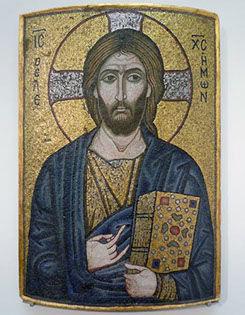
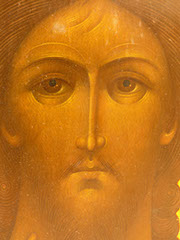
Suddenly, looking at the icon ‘Christ the Merciful’ I understood. Indeed, Christ the merciful is the merciful Person, not “the Mercy”. Mercy is lesser than Love, than God who is Love. This is why you cannot paint Christ and call the image ‘The Divine Mercy’.[15] To do that is to reduce the real Christ, God to one aspect and even more so – an aspect processed through the fallen human psyche. It is, in essence, making out of God someone one-dimensional, a tool for some purpose instead the Purpose. And this is what ‘The Divine Mercy’ appears to do.
And even if I am wrong in my line of thoughts the confusion remains: if 3.00pm was a particular moment of the outpouring of the Divine Mercy why do we need a new, quite questionable, image if we already have the iconography of the Divine Mercy known since the birth of Christianity that shows the very moment of the death of Christ at 3.00pm, with the stream of blood and water being poured out of Christ’s side?
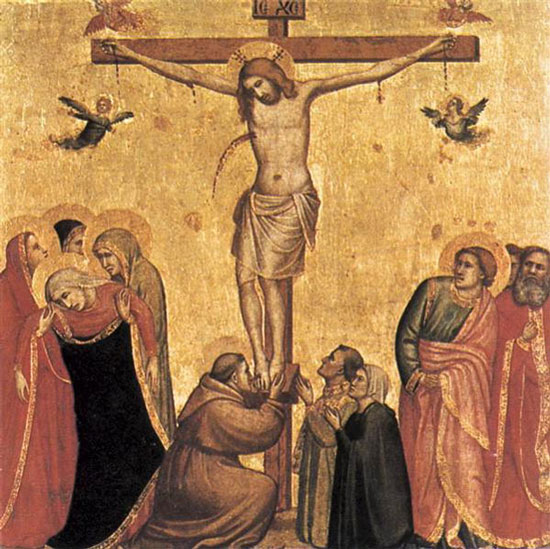
How is the picture of Christ-like figure standing in the darkness superior to the depictions of the death of Our Lord (does it add anything to them)? Or to the image ‘Christ’s Descent into Hell’ on which Christ breaks into Sheol and releases the imprisoned since the Fall humans out of it?
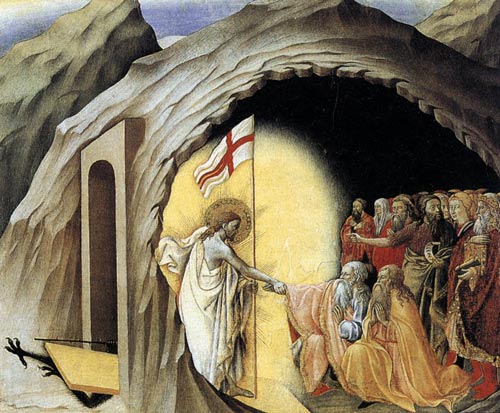
But this is not all. Apart from painted images of the Divine Mercy, we also have a three dimensional moving image, two streams, water and wine being poured now during every Eucharist as a clear reference to the coming Golgotha. I wrote it and had a sudden thought: what if we need that new strange image precisely because one cannot avoid the true death of the Lord on the images of the Crucifixion or during the Mass. Or, comparing ‘The Divine Mercy’ with the iconography of the Sacred Heart, perhaps we simply need now a less involved, non-suffering and consequentially non-demanding Christ, a “nice” Christ. This is why we need an image which shows only the fruits of death, two Sacraments severed from the bleeding Body of Christ and grafted onto some strange Christ-like figure. Or, more correctly, two “symbols”, the rays of something. No pain, the figure is “nice” and all that is required is to trust in the depicted.
I cannot prove my point with the words but I will try to prove it with the picture. I had a sudden idea to paint two rays on the image of the Crucifixion. Here it is.
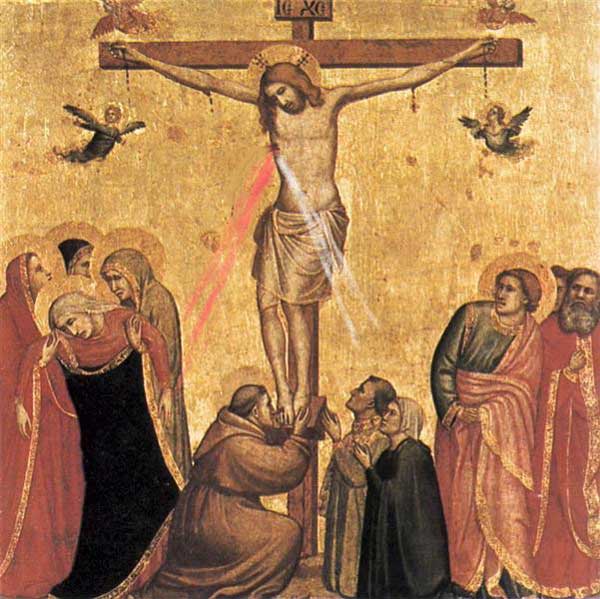
The rays here of course look out of a style yet they do not render the figure of the Crucified “a non-Christ” and do not make Crucifixion “unreal”. Furthermore, they are immediately read by Christians as blood and water. It is the real Christ on the Cross i.e., not Gnostic Christ but the real Christ Who make the two rays blood and water. So as usual it is all about the presence of the real Christ.
A double
When I was studying the material related to the revelation of the Sacred Heart of Jesus to St Mary Margaret Alacoque one painting immediately stood out to me [first below], not because of its artistic merits (although it is impressive in its very corporal force) but because it reminded me of another image [second below] well known in both Western and Eastern traditions.
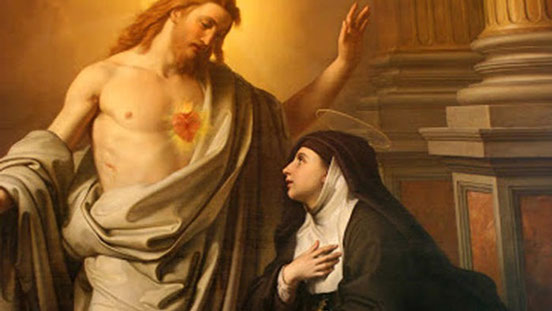
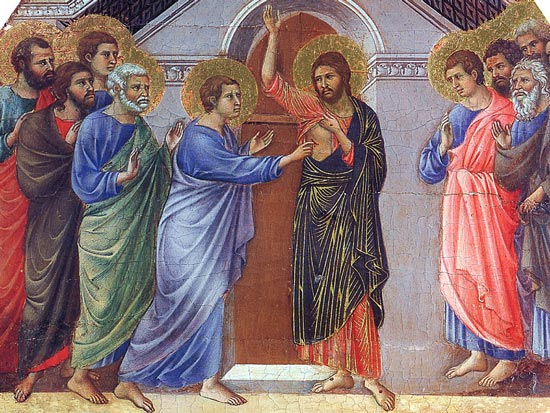
This is the image ‘Doubting Thomas’ or ‘The Assurance of St Thomas’ as it is called in the Eastern tradition.
I am not sure how I made that association. The postures of Christ are very similar indeed. On the first image He is showing to St Margaret Mary His suffering Heart; on the second He offers St Thomas to put his fingers into His wound (from which the Blood and Water were issued) and to verify that it is Him in flesh and blood and not just the spirit. I have never thought by the way of St Thomas as “unfaithful” – quite contrary, he stands to me as one who said when others were scared of Jesus’s determination to go to Jerusalem where He would be killed “Let us go and die with Him”. St Thomas was not present in the room when Jesus appeared to the apostles after His resurrection so his doubts are understandable, I think.[16]
An icon ‘The Assurance of St Thomas’, in the context of the many Gnostic heresies[17] which flooded the Church almost immediately after its birth, is for me the most anti-Gnostic icon. Here is Christ, in flesh and blood, with His stigmata and halo with the Cross looking at St Thomas and commanding him to make sure it is Him. And here is St Thomas, trembling but doing what the Lord told him to do. There are also witnesses.
The painting shows St Margaret Mary Alacoque looking at the Sacred Heart of Jesus, a very corporal Jesus is psychologically also very anti-Gnostic, to me. “It is me, with the wound in My side and not just that – apart from being wounded on the Cross I have also been wounded by the indifference by those for whose sake I got those wounds. Look at my very humane heart, as well as divine”. St Margaret Mary looks very much like St Thomas. The body and face of both have an expression of recognition and awe. The Lord was merciful to show to St Margaret Mary (and to us, via her) His suffering Heart just like He was merciful to show His wounds to the doubting St Thomas. In essence, it is the depictions of the meetings with the Resurrected Lord in flesh and blood.
When analyzing ‘The Divine Mercy’ image I was not planning to write about the liturgical change caused by that image and the cult, namely, the decision of John Paul II to insert it into the last day of the Easter Octave calling it ‘The Divine Mercy Sunday’. The Octave is celebrated as one long festive day of the Resurrection of Christ. The eighth day of that period is called “Antipascha” (“opposite Easter”) or “The Sunday of St Thomas” in the Eastern Orthodox tradition; in the Roman Catholic tradition it is called ‘Low Sunday’. In both Churches, Orthodox and Catholic, the liturgical readings are about the event of the assurance of St Thomas. This is entirely logical and the massage is fundamental to our faith: He is risen, we saw Him and touched Him. The experience of St Thomas is probably the most corporal and graphic among such in the Gospels and this is why it is so fitting for the conclusion of the Easter Octave so as the words of Christ “Thomas, because you have seen Me, you have believed. Blessed are those who have not seen and yet have believed.”
A change of St Thomas Sunday into The Divine Mercy Sunday caused strange oblique incoherencies. The most obvious and discussed by many is the fact that now the faithful have the Divine Mercy Novena, the nine days prayer which starts on Passion Saturday. And so those who pray it (not so many yet) participate, without knowing it, in a parallel something, a parallel to more than twenty centuries of liturgical focus, of both Western and Eastern Churches, on the real Easter events. Onto very corporal events of the death, Resurrection and, most importantly, onto various accounts of those events by the witnesses including very personal and emotionally charged interactions with the Risen Lord in a particular place and time is being superimposed something oblique, a solitary Christ-like figure with the “symbols” of blood and water, self-absorbed, without the marks of Passion or the Cross or witnesses. Somehow that clean, lifeless figure is called “The Divine Mercy” and now this image is swopped with the image of Thomas putting his fingers into the flesh of the risen Christ or the image of the Resurrection.
And, since the image called ‘The Divine Mercy’ is actively distributed in the churches during the time of the new novena (which begins on Passion Saturday and continues for the whole Easter Octave), first on the novena cards and then, finally, solemnly erected in front of an altar on the last day of the Octave, it is naturally being perceived as an image of the Resurrected Lord. That means, the image of the ‘Divine Mercy’ has somehow pushed away not just the Sunday of St Thomas but the Resurrection of Christ as it was known to the Church for more than twenty centuries.
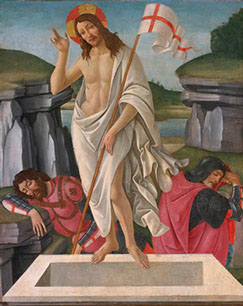
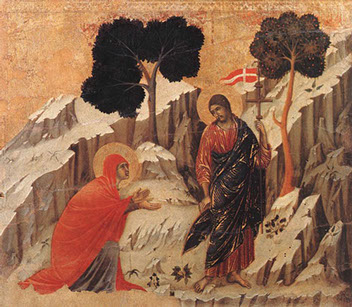
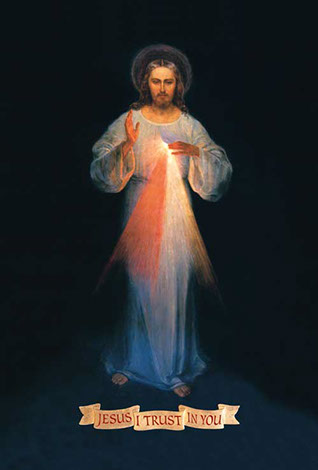
By no means am I saying “look, faithful, there is a deliberate conscious swap here, of a true image of Our Lord with something very questionable, a kind of an imposter”. No, what I am saying is that with the approval of the Divine Mercy cult and especially with the changes within the most important period of the liturgical year, its heart as well as the heart of our faith, some oblique, shadowy area was created – a space for a double perhaps – where until recently has been only the assuring bright light of the Resurrection. I say “oblique” because it is so hard to pin it down with words. If I say (as some Roman Catholics do, expressing their surprise with the change) that it is not really a good idea to insert the Feast of the Divine Mercy into the Easter Octave the answer would be “But it is not new, isn’t God merciful and the Easter is a time of great mercy?” If I say “St Thomas’s Sunday is obliterated in effect” the answer would be “It is not, we still have the readings”. Yes, we still do but we also have something else now and the most important, to my mind, is that something else or “someone else” does not fit the Octave. He is too superficial and “nice” – the qualities which become apparent only when being compared with the real Christ and His Church’s treatment of Him.
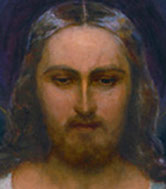
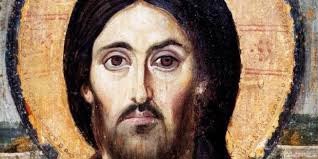
It is not the “sweetness” that makes the image of the Divine Mercy questionable – the original is not particularly sweet and we have plentiful overly sweet images of Christ produced in 19-20cc. in the West, especially of the Sacred Heart. However sweet and tasteless those images are, they are never impersonal or empty. It is, I insist, the sense of emptiness and unreality, of a meaningless addition. The Christ-like figure of the original painting of the Divine Mercy does not have a core hence it looks unreal. It is anything, it is ready to please, to compliment, to praise excessively. It is ready to be anything the viewer wants. The image of the divine mercy then is a reduction, not even a reduction of Christ to “mercy” but a reduction of “mercy” to “niceness” so even two rays, the “symbols” of Christ’s Blood and Water, cannot save the situation and make out of that figure the real Lord. This is precisely why, to match “a symbolic Christ”, its author had to make “symbolic blood and water”. Indeed, they can never be seen as real, unlike highly stylized drops on some medieval paintings – although they are stylized, they are real blood and water and are perceived as such.
To make a total, the Church has had first St Thomas putting his fingers into the real wound in the side of the Lord Who is looking at him, then – St Margaret Mary Alacoque contemplating the real Heart of the Lord who is looking at her and now we have a Christ-like heartless and woundless figure looking into himself; from the middle of the figure’s chest two rays, red and white are issuing into the dark space. I leave it to the reader to figure out what this change may signify.
Now let us consider the fruits which are ripening in the oblique domain of the double.
In her own image
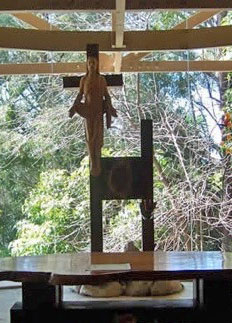
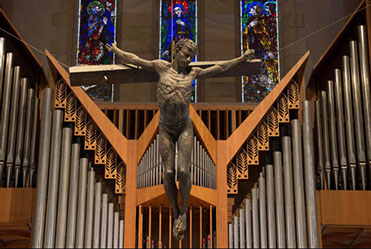
I have no idea of how the original image of the Divine Mercy came into the world meaning that I have no way of knowing what exactly moved Sr Faustina. It is not important for an evaluation of the image. What important however is that the image of the Divine Mercy somehow fits into the modern phenomenon, of the urge to do something with the depiction of the Crucifixion until the Cross disappears or Christ is no longer nailed to it, creating some kind of a bloodless or “as if” sacrifice instead of the real thing. “As if” sacrifice probably describe that phenomenon best. True depictions of the Crucifixion do not leave the grey areas which can be filled with something – something that a human psyche desires or that a fleeting moment dictates.
We know from the Church history that the denial of the reality of the Crucifixion of Jesus Christ is a hallmark of Gnosticism. I am quite convinced that we are living in a time when Gnosticism, being a counter-Christianity, has shed all its pseudo-theological clothes and became a naked expression of a human psyche which is unable to accept God as He is, on His terms, together with His demands to be transformed into His likeness. This psychological Gnosticism does not openly reject Him but attempts to smother, control and melt Him down, slowly transforming Him into her (human psyche) likeness. Simply speaking, she is trying to make out of the Ultimate Goodness a mere nicety.
Thus, unlike the Christ of the Sacred Heart, the Christ-like figure of the Divine Mercy is neither engaging not demanding. He even does not look at the viewer. He is simply there, pouring graces onto whoever accepts him, being nice. That’s it. Somehow the image reminded me the description of “something there” in my essay ‘Metaphysical double bind’:
“The faith in “something there”, new age ideas and so on appear to be very infantile, intellectually extremely undemanding and very much on “consumerist end” meaning that a human being receives without giving anything back. “Something there” does not demand that a believer would learn about “it”. It is like someone would stand under a nice, warm shower being miraculously poured upon him without a slightest desire to learn where it comes, why, and what all that is about. Hence here is the second self-construct, of a love of some benevolent mother-like “thing”, an impersonal mother principal whose “outpouring” a believer simply accepts, just like a baby accepts the love of his mother.”
There I spoke of the modern believers in “something” – for example mother Earth or another principal, typically female. A term “female” is apt from a psychological point of view; “mother earth” or “mother goddess” correspond to the stage of a human development when a baby is being fused with his mother. It is a stage of an infantile narcissism.
Psychological Gnosticism represents a new stage, of a thwarted development – a person who, for whatever reason, was formed to believe that being “nice” is the major virtue and anything can be sacrificed for that virtue, even being genuinely good. As it was mentioned before, it is often a victim of subtle emotional abuse who has learnt that only via being “nice” i.e., sacrificing her real self to the unreasonable demands of her parents she may get what she wants. Thus being “nice” is an unconscious manipulation absorbed with her mother’s milk so to speak. The problem there is that, if a child constantly suppresses the legitimate needs of the real self out of a fear to be punished for being who she is, she eventually will lose a touch with her real self = with herself, she becomes a shell of herself. And so she lives in the superficial world initially constructed by just as broken parents and later perpetuated by her. The further it shrinks from the real pain and real life, the bigger is self-deception and the further she is from the hope to ever discover a true relationship including with the real Christ.
The real Christ and a “nice” person dwell in the parallel realms so to speak; to bring a person to Himself Christ must break into her real self. However, If the real Christ on the true icons can look demanding, hurt and even disapproving, how can the soul who has spent all her life avoiding those emotions relate to such not nice images? She may say (to be nice) that they are “beautiful” yet she quietly prefers her own, “nice” Christ, made in her own likeness.[18]
A pleasant cult
The superficiality of “being nice” as a mode of a life in the world can pass unnoticed and even make a person superficially happy (while leaving her miserable deep inside). The same mode of a life, being transferred into a metaphysical realm (the Church), looks much more out of a place and brings much more harm, to a soul and to the Church.
First of all, the very criteria of what is good and what is evil is twisted by such a soul. To be nice is more important than to be good thus the lesser and determined by the others subjective value is somehow higher than the bigger and objective value, the good determined by God. If God is the Ultimate Good than it can be interpreted as “a subjective fleeting human niceness that is higher than the objective eternal goodness of God”. That means that the world/the lens through which such a person sees others are literally reversed, being the anti-world and anti-lens.
Second, the relational realm of such a person is hugely a fake. It is impossible to truly relate to her because there is no guarantee that her response (typically praise and flattery) has anything to with the reality and with what she really thinks. In a sense, it is not so different from a relationship with an abuser who undermines (i.e., lies) non-stop because he is lying as well. Paradoxically, it is easier to break away from the abuser because one feels a pain while dealing with him and the pain signals that something is wrong. While dealing with a “nice” people pleaser one may first experience elation of “being validated”[19] which eventually will give a way to a murky sense of unreality and dismay, of even being tricked. “What is this? Maybe I am a very mean, suspicious person and she is very good, a saint really?” In the context of God and the Church such doubts are particularly damaging because the Church is supposed to be a place of truth and a true healing. Since God demands sincerity from the faithful, it is natural to expect some basic sincerity from them and to give an advance of trust, especially to priests or religious. The Church also teaches that we must love others so it is easy to attribute the excessive niceness to the excess of love.
Yet there is a huge difference between the two. A true love sees and reflects the other as he is (this is what Christ did), good and bad, with love that is seeking the true good of the other. In the context of the Church, the true good is to be with God and to be with God means getting rid of all that is an obstacle to it, own sinfulness. A true Christian love then seeks to turn a person away from bad and to usher him towards God; this is impossible without acknowledging the existence of that bad and confronting it when it is needed. That means risking to be perceived as “not nice”.
Contrary to love, “niceness” does not reflect the other at all. It reflects a convenient for a “nice” person construct of the other. The more inflated the construct is the nicer is the “nice” person. To phrase excessively someone’s less than mediocre work (I am not speaking about the cases when it is necessary because of the true charity like with a handicapped or depressed person) means that the pleaser is “generous”. However, her “generosity” benefits only her.
The effect of such an attitude, among the like-minded, is that the realm of rosy magnified reflections, mutual tickling of the inflated fake selves and elation caused by that tickling is being spun, essentially the realm of worshiping “the goodness of the circle” which is taking its members further and further away from the sober realm of Christ, the realm of real relationships and real selves. But, because Christians cannot do without Christ, a new, “a nice, smothered Christ” is typically being reconstructed within such a circle out of the real, melted and deconstructed Christ – one who can contribute to the elation and other pleasant feelings. Thus, Christ becomes a tool for a spiritual self-gratification – something the true Christ abhors as we learn from the mystics.
Considering that only a true self can recognize the truth and relate to Christ Who is the Truth, the deliberate feeding the fake self and creating an addictive spiritual “high” means ripping a person off the possibility of relating to Christ and an ability to develop a sober discernment necessary for spiritual life. That means that in coming to the Church damaged persons, “nice” and not nice – abused, broken, in a desperate need for a validation and healing – are being fooled by the self-seeking nicety of those who exploit their need and will lose their only possibility of a true healing left, in the relationship with the real Christ because the need for such healing was hijacked within the Church. Within and yet without – because the circle, for its member, while being within the Church effectively swaps the Church with itself, in a strange similarity with ‘the Divine Mercy’ image during the Easter Octave superimposed over the real Christ.
* * *
The phenomenon that is hinted by the image of the Divine Mercy is not yet openly antichristian or better to say counter-Christian. It looks as if someone is trying to recreate something while missing that which is most important in that something, that holds it all together. It is a soul that does not “get” Jesus Christ in flesh and blood with ever-changing expressions on His Face, who does not wish to face a pain and to relate in truth or perhaps she does not even know what it means. It is a soul that is not perturbed by the words of the supposed Christ to Sr Faustina, like “tell the Superior General to count on you as the most faithful daughter in the Order” or “My daughter, if you wish, I will this instant create a new world, more beautiful than this one, and you will live there for the rest of your life”[20] so she takes them on board and lavishes similar hyper flattery on others thinking that this is “love” and “validation”.
Wow!
I was thinking about how Christ would deal with a community of the religious who live according to one rule only, “being nice”, substituting a true love with niceness, true reflection of who the person is with a narcissistic magnifying rosy mirror calling it “validation”, taking turns to look into it and to glow in an inflated reflection.
I imagined Christ back in a time saying to the crowed any of His maxima, for example “Blessed are the poor in spirit, the kingdom of heaven is theirs.” I tried to imagine the most hostile reaction like “What an idiot! Obviously, he has never been poor” or “This man is delirious”. You know what? – Now it does not sound bad at all because it still holds a potential. Christ could say “Why do think I am not poor? – I am” or “you missed the point, “poor in spirit” or whatever but what would He say to – let us repeat:
Jesus Christ: “Blessed are the poor in spirit, the Kingdom of heaven is theirs.”
The people: “Wow! It is brilliant! Wow!!”
That would be a masterful way to shut Christ up with “a validation” I think – unlike that other one who will make a slight bow, smile and say to himself “I am being appreciated at last”.